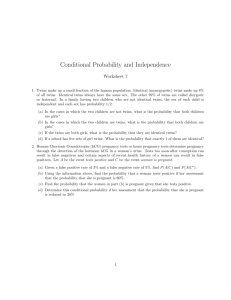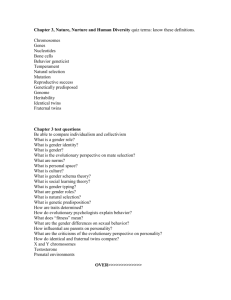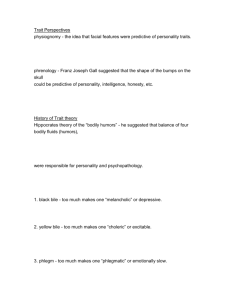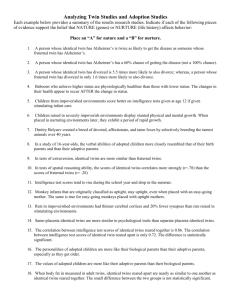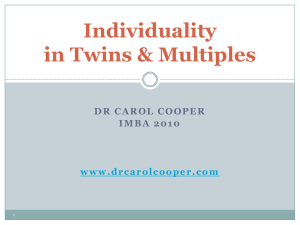File
advertisement
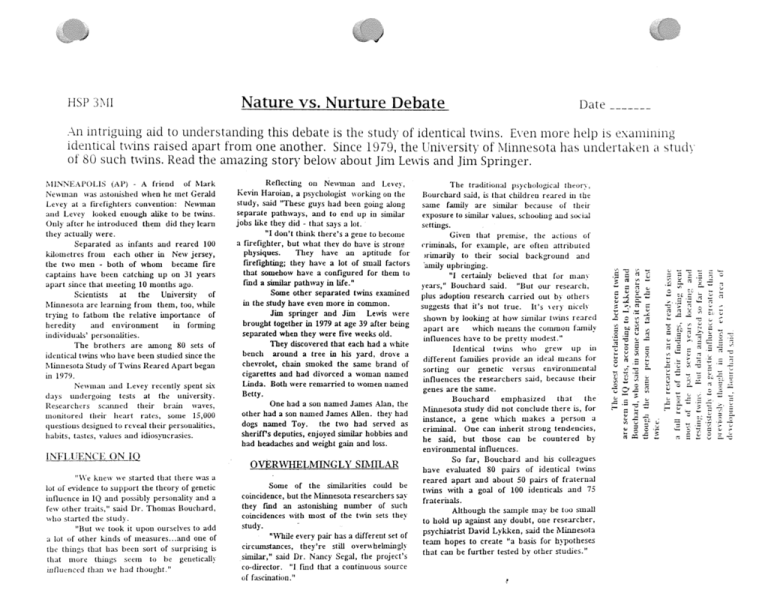
Nature vs. Nurture Debate
HSP 3M1
Date
An intriguing aid to understanding this debate is the study of identical twins. Even more help is examining
identical twins raised apart from one another. Since 1979, the Iniversity of Minnesota has undertaken a studs
01 80 such twins. Read the amazing story below about Jim Lewis and Jim Springer.
MC’NEAPULIS tAP)
A friend of Mark
‘seuian was astonished when he met Gerald
Lesey at a luctighters convention: Newman
and Lcvev looked enough alike to be twins.
Only after he introduced them did they learn
they actually were.
Separated as infants and reared 100
kilotnetres from each other in New jersey,
the tssu men
both of whom became fire
captains have been catching up on 31 years
apart since that meeting 10 months ago.
Scientists
the
University
at
of
Minnesota are learning from them, too, while
trying to fathom the relative importance of
and environment
heredity
in forming
individuaL’ personalities.
The brothers are among 80 sets of
identical twins who base been studied since the
Minnesota Study of Twins Reared Apart began
in 1979.
ewuiaii and Levey recently spent six
d.is un(Iergtnng tests at the university.
Researchers scaimed their brain waves,
uiomtored their heart rates, some 15,000
questions designed to reveal their personalities,
habits, tastes, values and idiosyncrasies.
-
-
IFiUENCE ON 10
“We knew sse stat-ted that there was a
lot of evidence to support the theory of genetic
influence in IQ and possibly personality and a
few other traits,’ said Dr. Thomas floucbard,
wlii started the studs
“But we took it upon ourselves to add
a Lt of other kinds of measures. ..and one of
the things that has been sort of surprising is
that inure things seem to be genetlCall
intlu,riced than sic had though’
Reflecting on Newman and Levev,
Kevin Ffaroian, a psychologist ssorking on the
study, said “These guys had been going along
separate pathways, and to end up in similar
jobs like they did that says a lot.
“1 don’t think there’s a gene to become
a firefighter, but what they do have is stron?
physiques.
They have an aptitude for
firefighting; they have a lot of small factors
that somehow have a configured for them to
find a similar pathway in life.”
Some other separated twins examined
in the study have even more in common.
Jim springer and Jim
Lewis were
brought together in 1979 at age 39 after being
separated when they were five weeks old.
They discovered that each had a white
bench around a tree in his yard, drove a
chevrolet, chain smoked the same brand of
cigarettes and had divorced a woman named
Linda. Both were remarried to women named
Betty.
One had a son named James Alan, the
other had a son named James Allen. they had
dogs named Toy.
the two had served as
sheriff’s deputies, enjoyed similar hobbies and
had headaches and weight gain and loss.
-
OVERWI{ELMTNGLY SIMILAR
Some of the similarities could be
coincidence, but the Minnesota researchers say
they find an astonishing number of such
coincidences with most of the twin sets they
study.
“While every pair has a different set of
circumstances, they’re still overwhelmingly
similar,” said Dr. Nancy Segal, the project’s
co-director. “I find that a continuous source
1)1 fascination.”
The traditional psychological theors,
Bourchard said, is that children reared in the
same family are similar because of their
exposure to similar ‘ralues, schoolinti and social
settings.
Given that premise, the actions nt
erininaL, fur example, are often attributed
wirnarily to their social background and
amily upbringing.
“I certainly believed that fur man’
years,” Bouchard said. “But our research.
plus adoptiou research carried out b others
suggests that it’s not true. It’s sety niceR
shown by looking at how similar twins reared
which means the common family
apart are
influences have to be pretty modest.”
Identical twins who grew up in
different families provide an ideal means for
sorting our genetic versus environmental
influences the researchers iaid, because their
genes are the same.
the
that
emphasized
Bouchard
i’,Iinnesota study did not conclude there is, for
instance, a gene which makes a person a
criminal. One can inherit strong tendencies,
he said, but those can be countered by
environmental influences.
So far, Bouchard and his colleagues
have evaluated 80 pairs of identical twins
reared apart and about 50 pairs of fraternal
twins with a goal of 100 identicals and 75
fraterisals.
Although the sample may be too small
to hold up against any doubt, one researcher,
psychiatrist David Lvkken, said the Minnesota
team hopes to create “a basis for bvpotheses
that can be further tested by other studies.”
—
a
—
—
a
—t
*
-
—


